
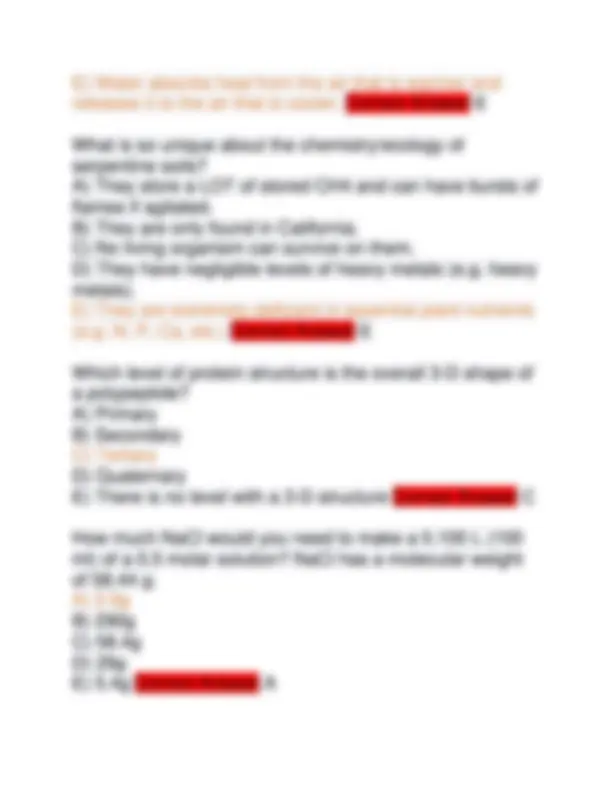
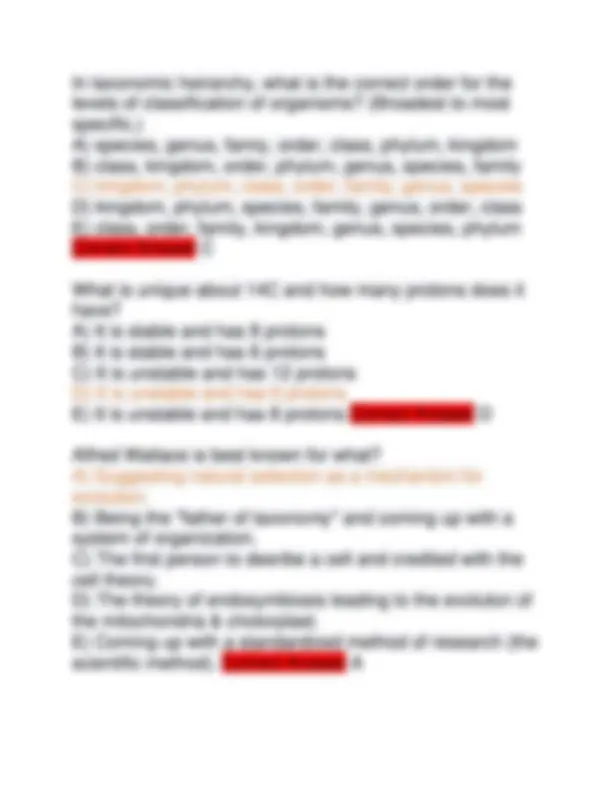
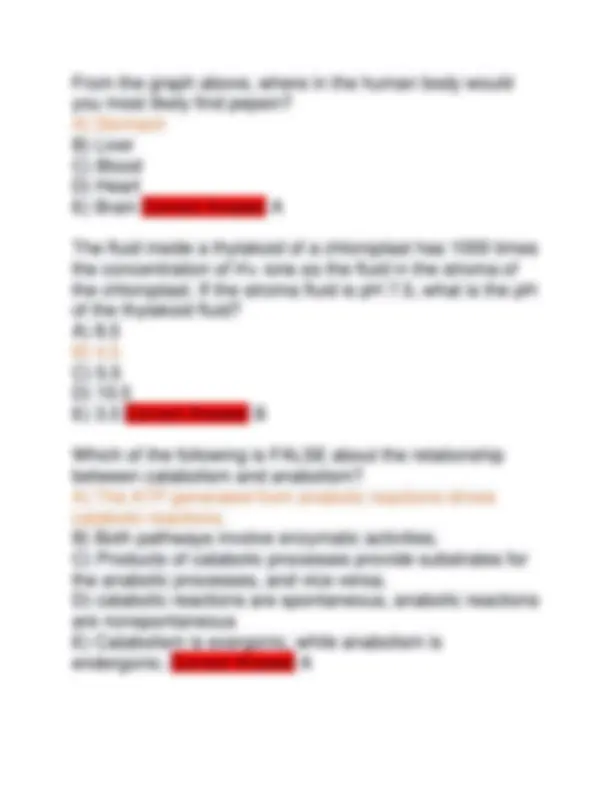
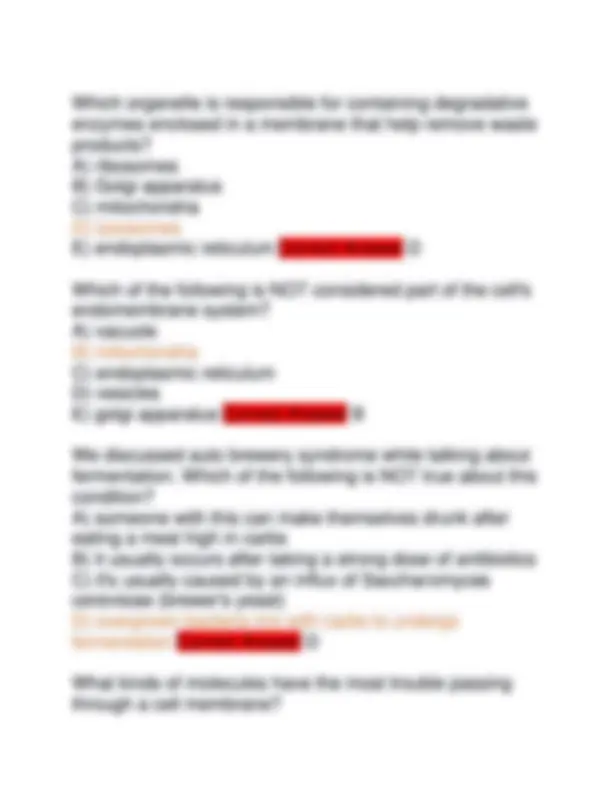
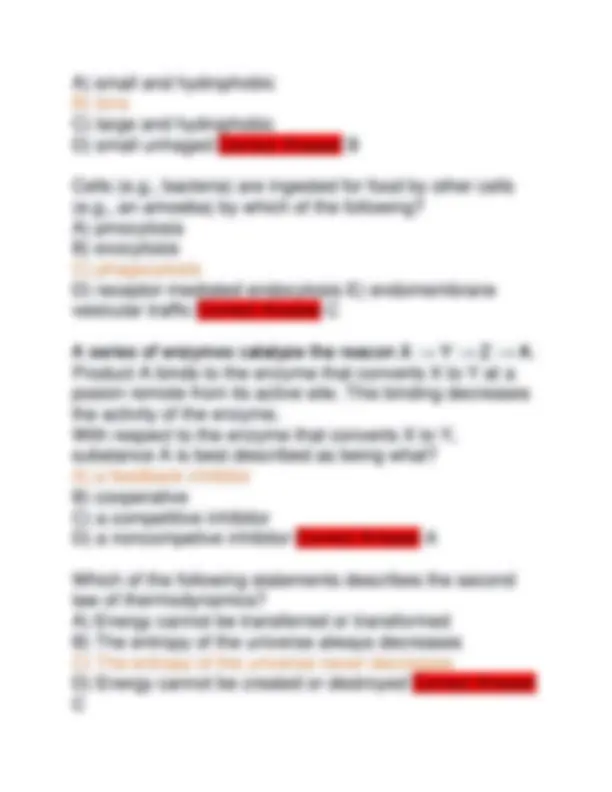
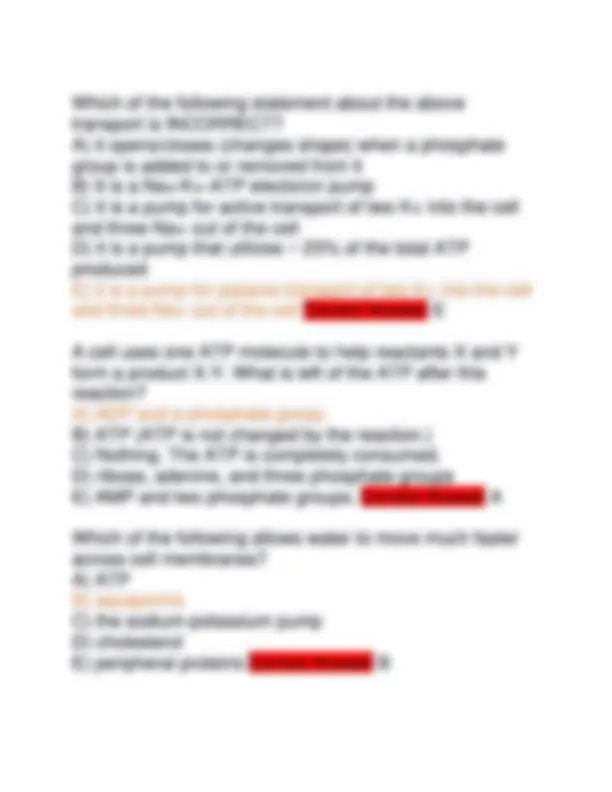
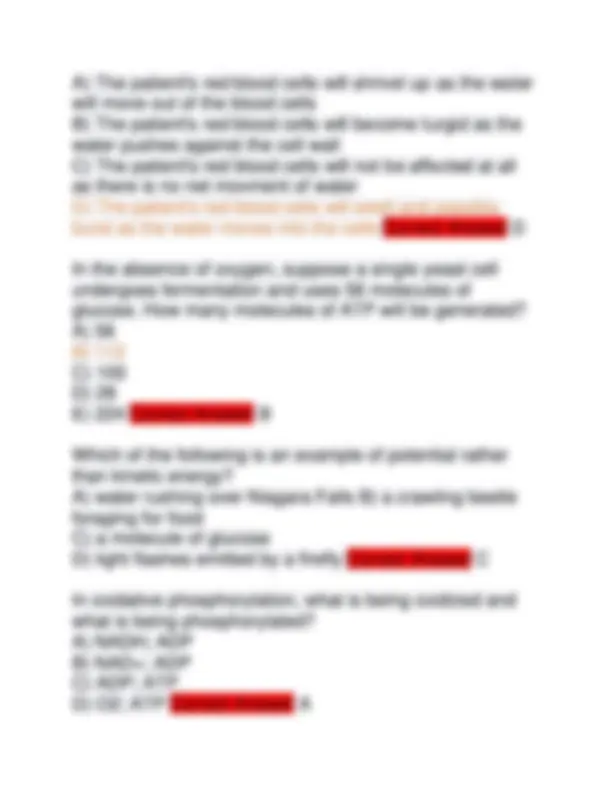
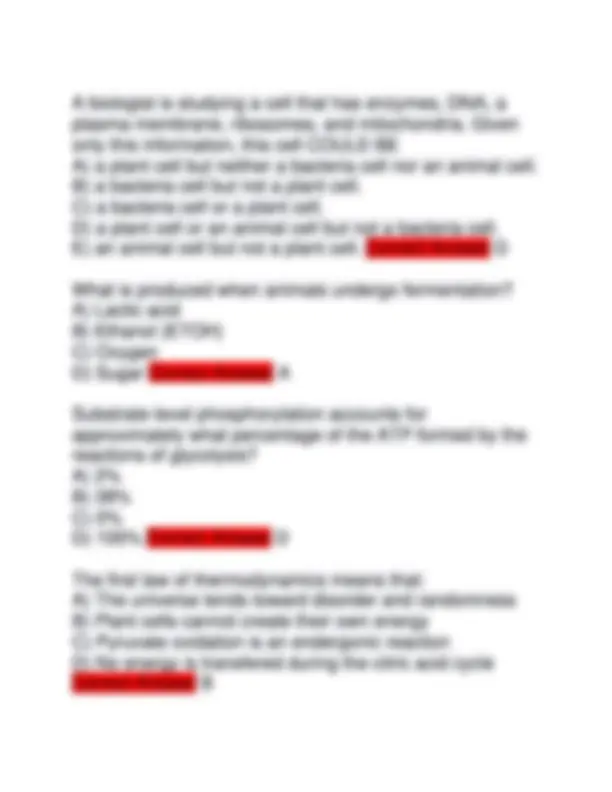
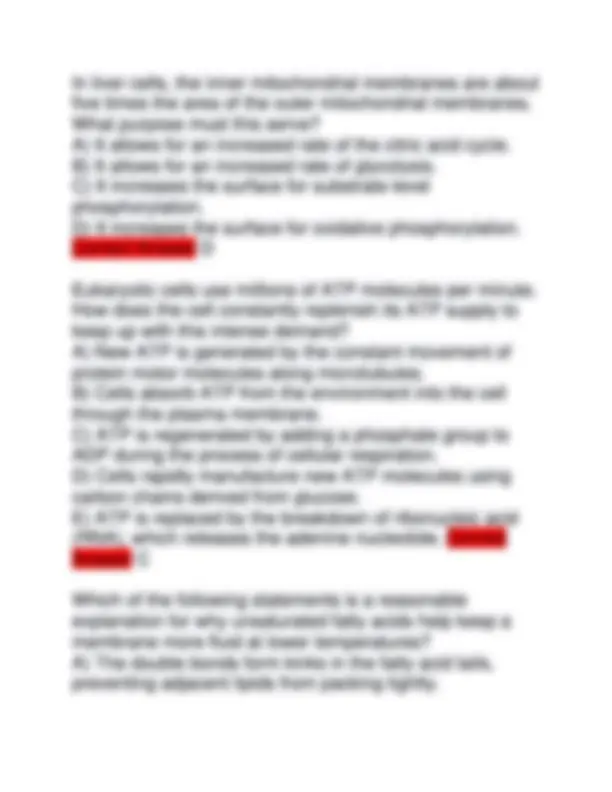
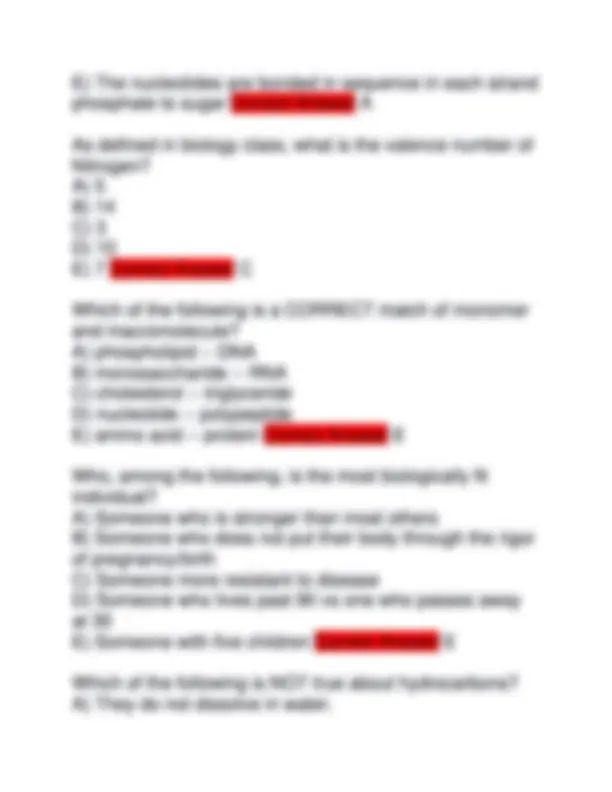
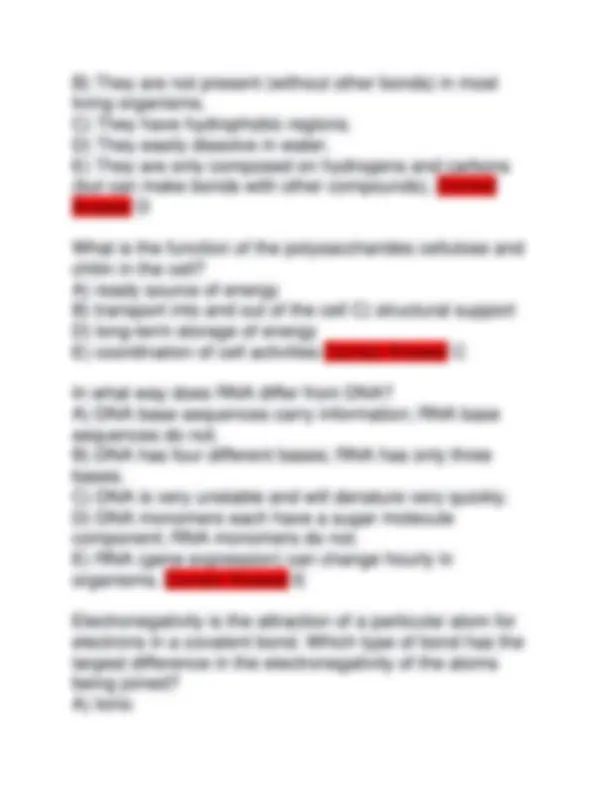
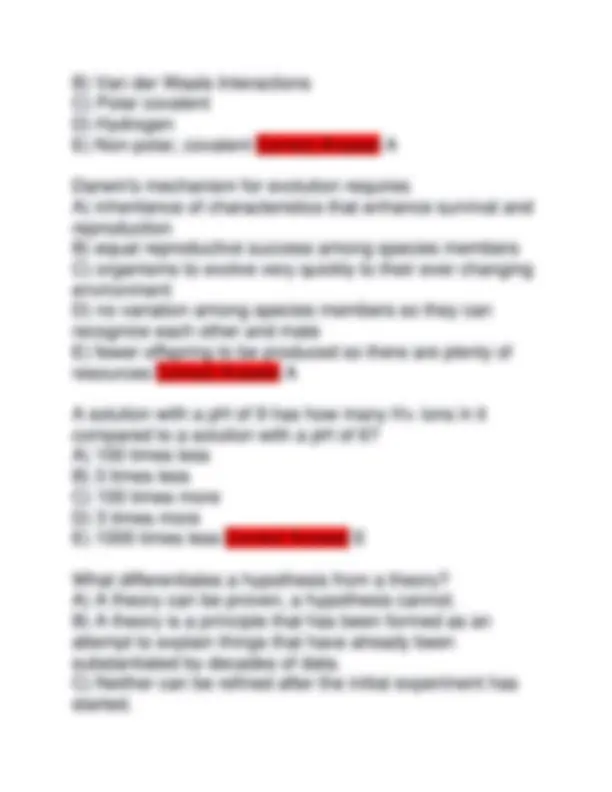
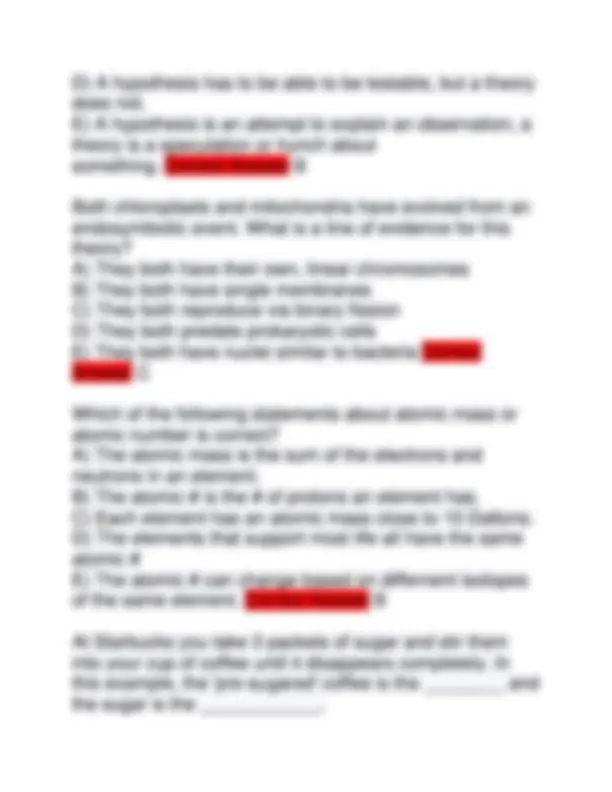
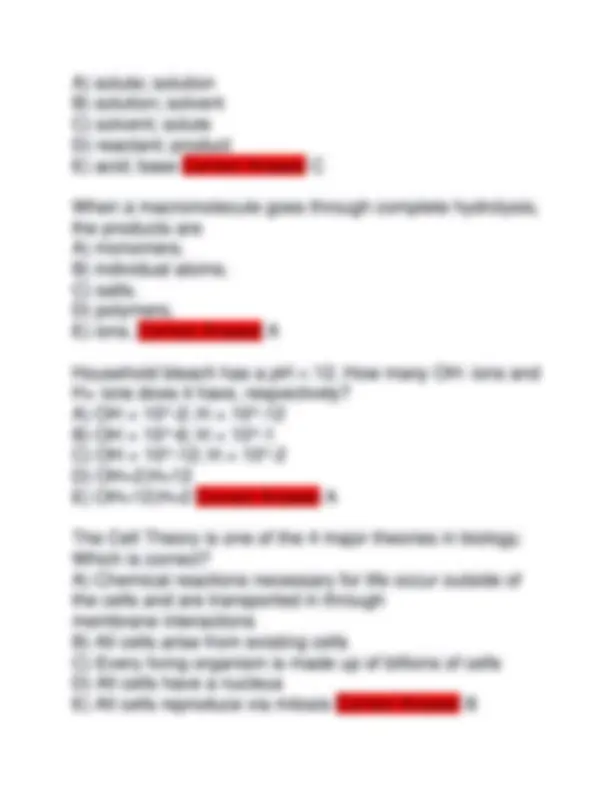
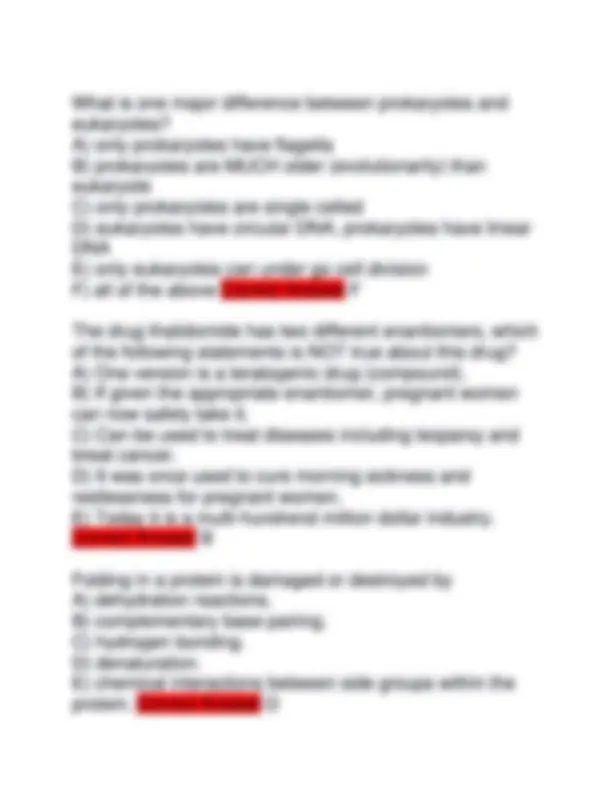
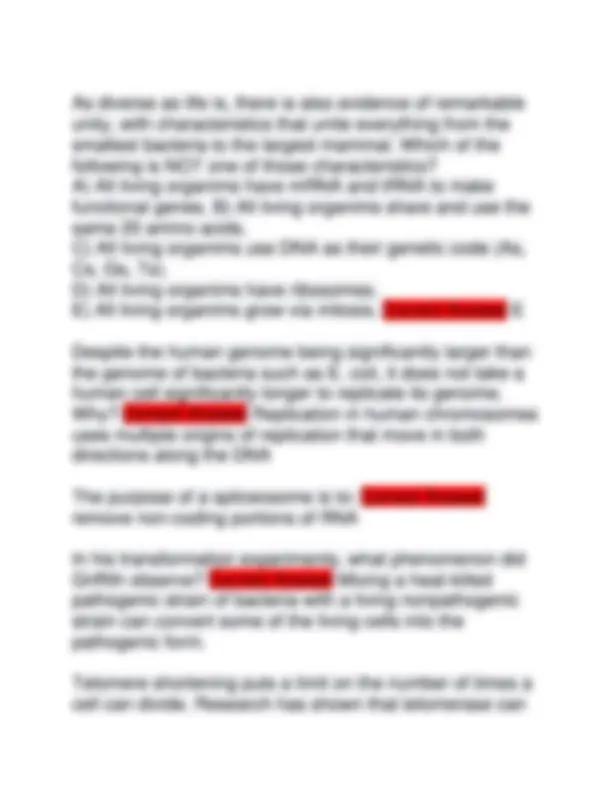
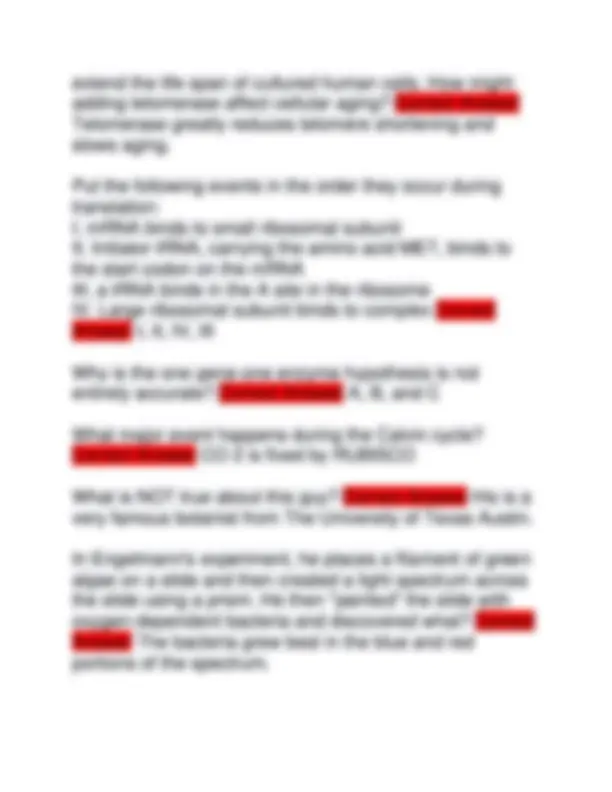
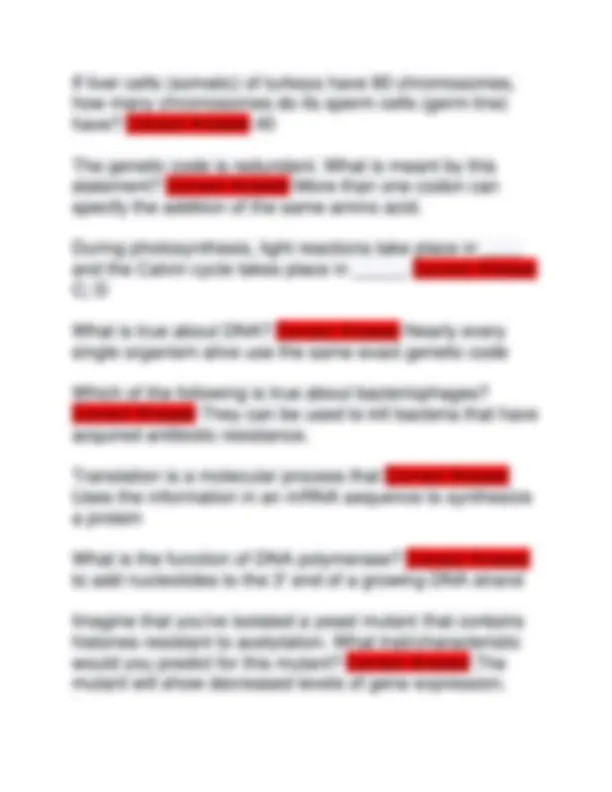
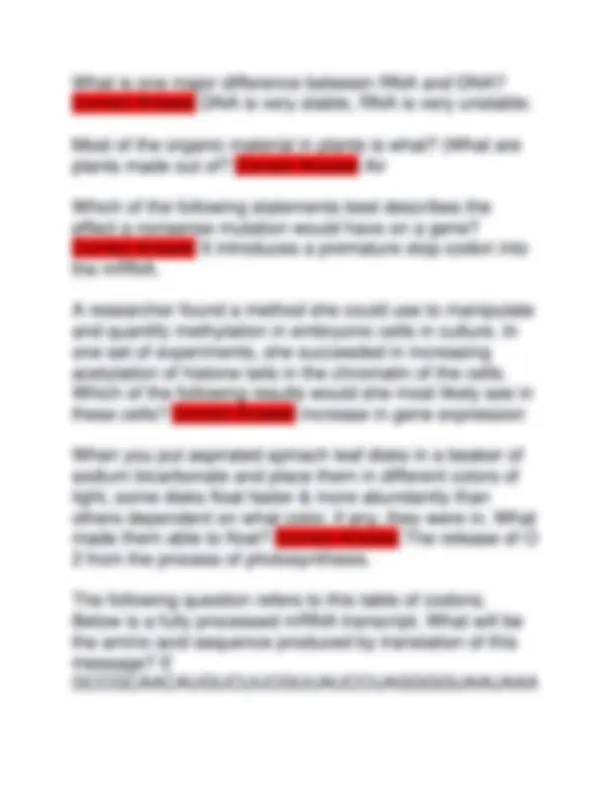
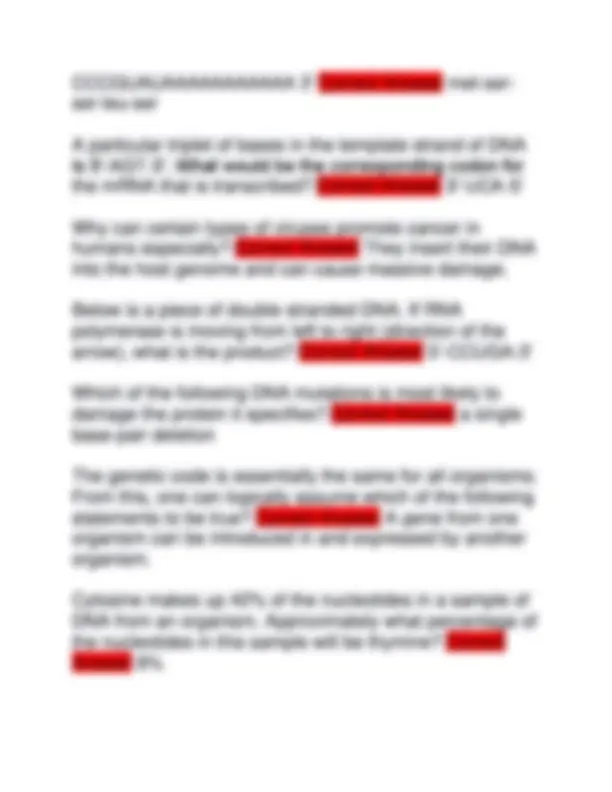
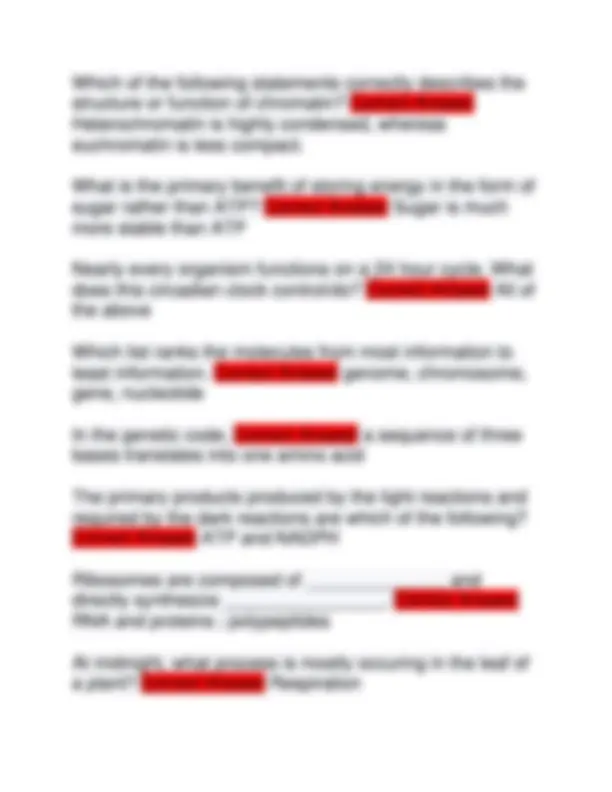
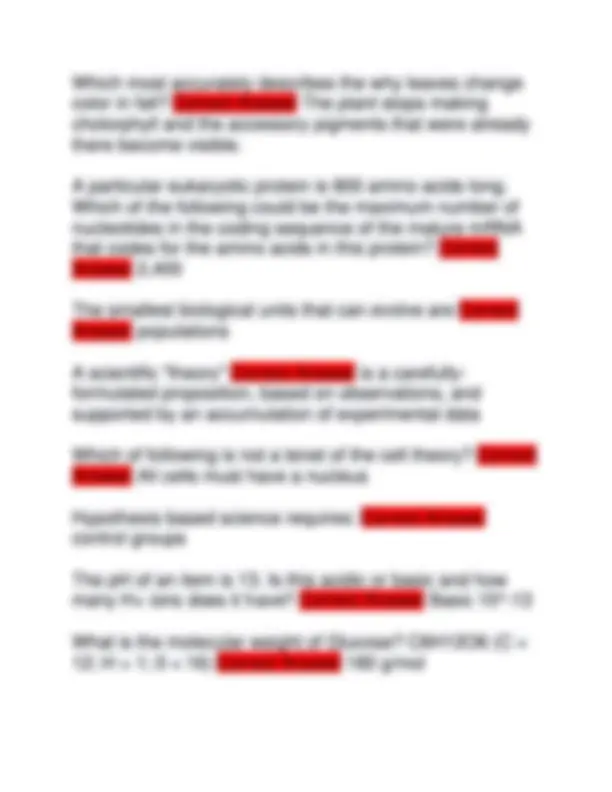
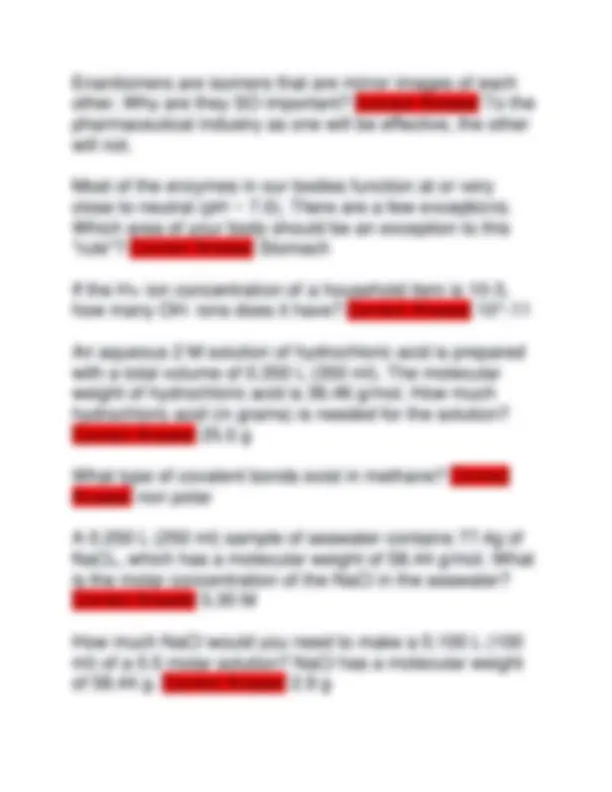
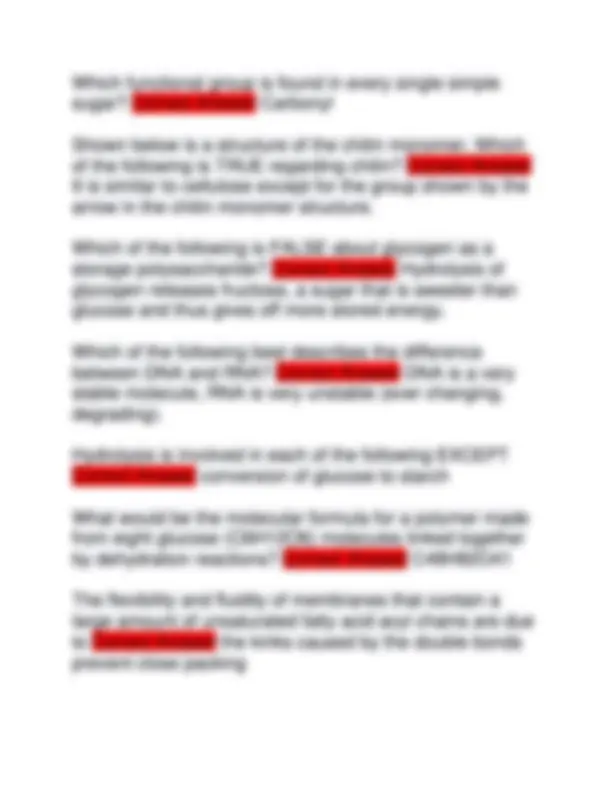
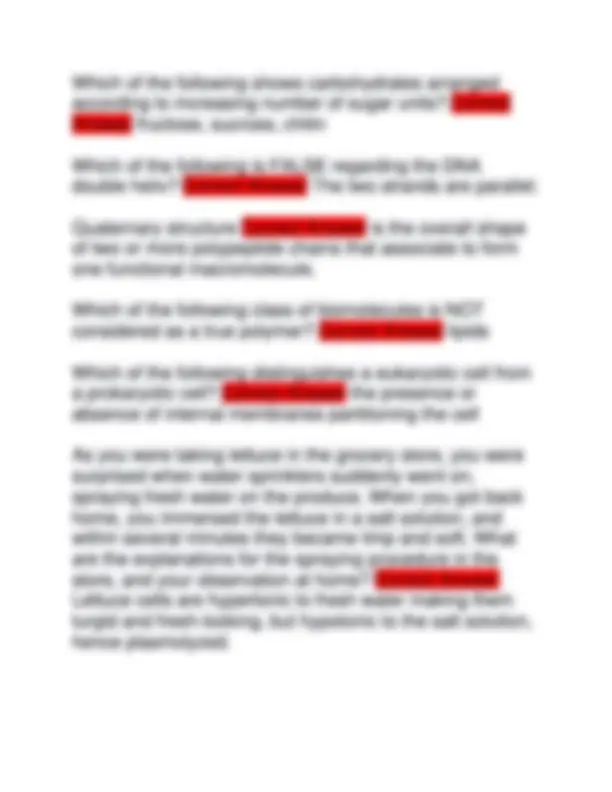
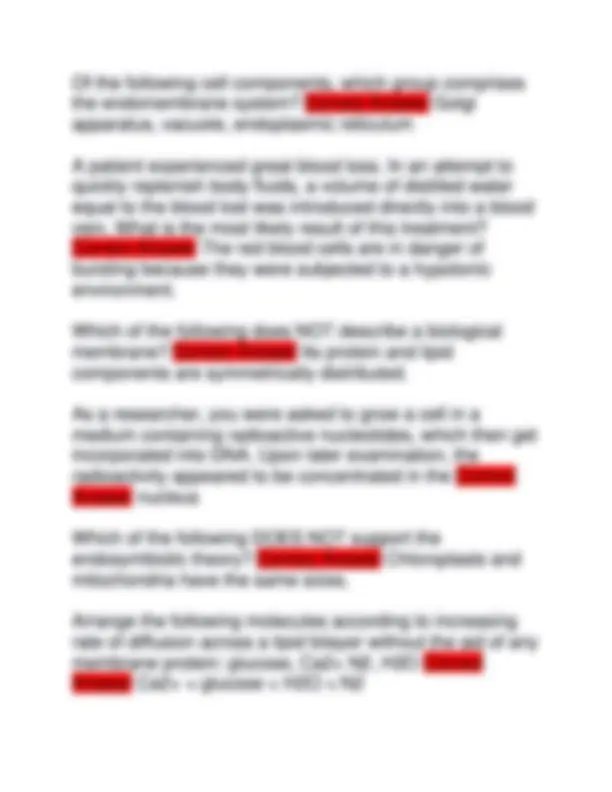
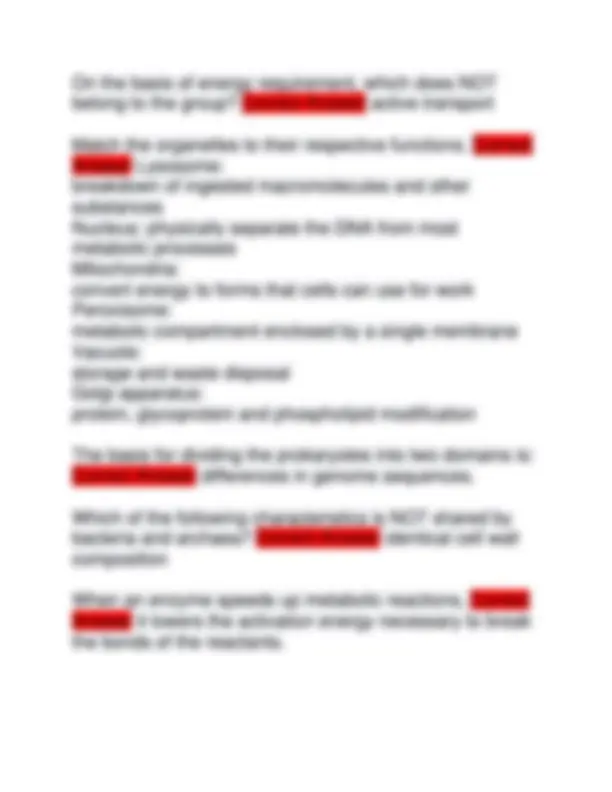
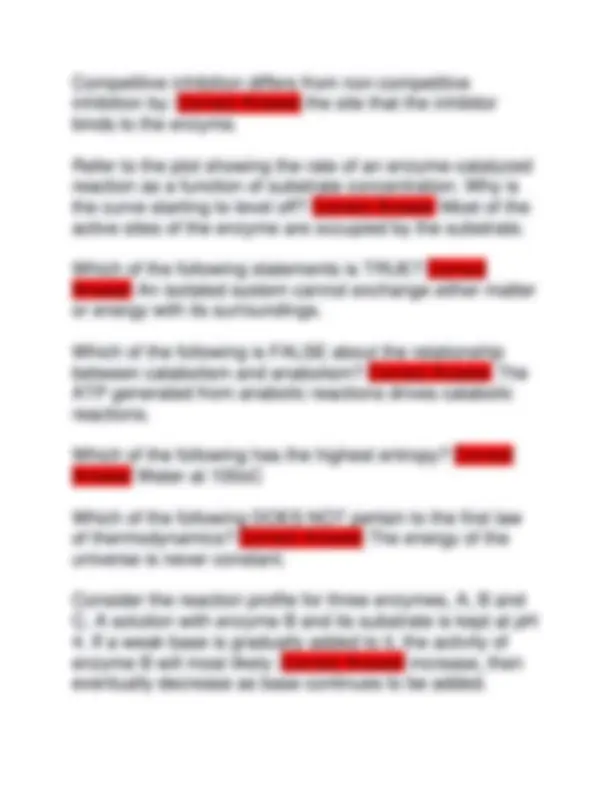
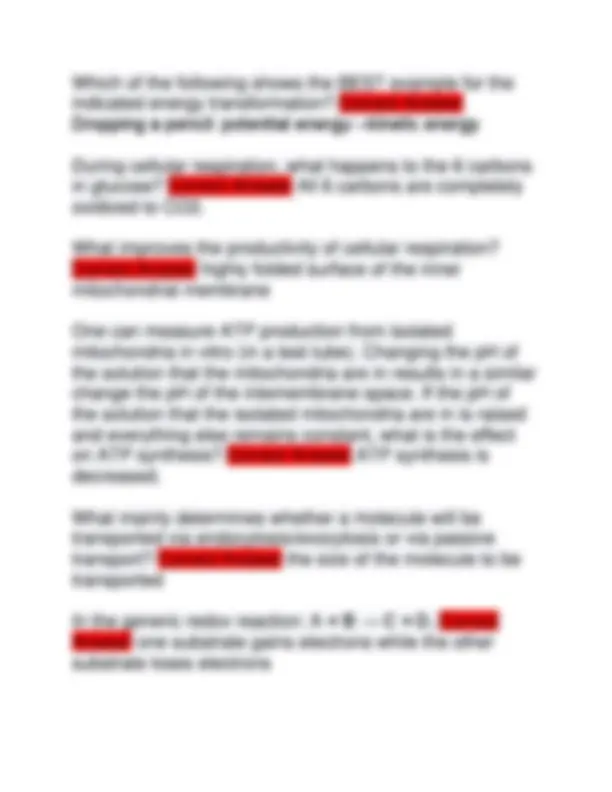
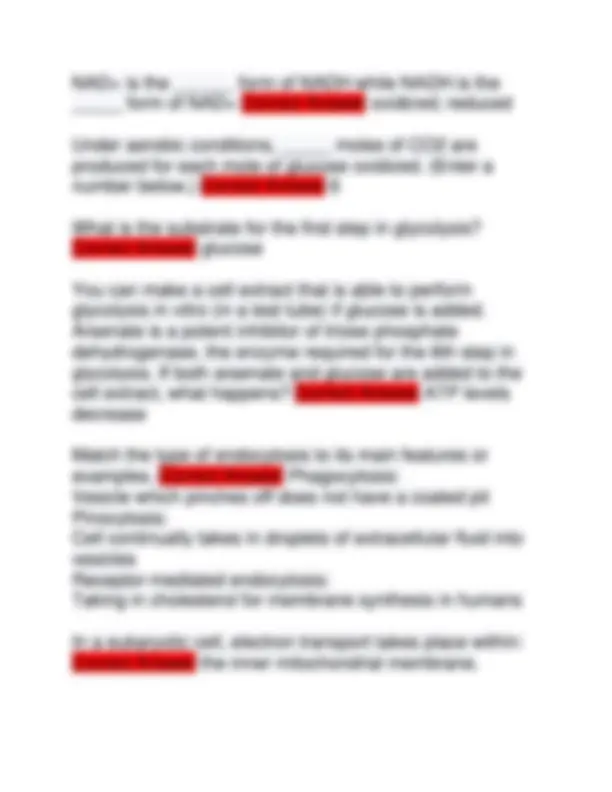
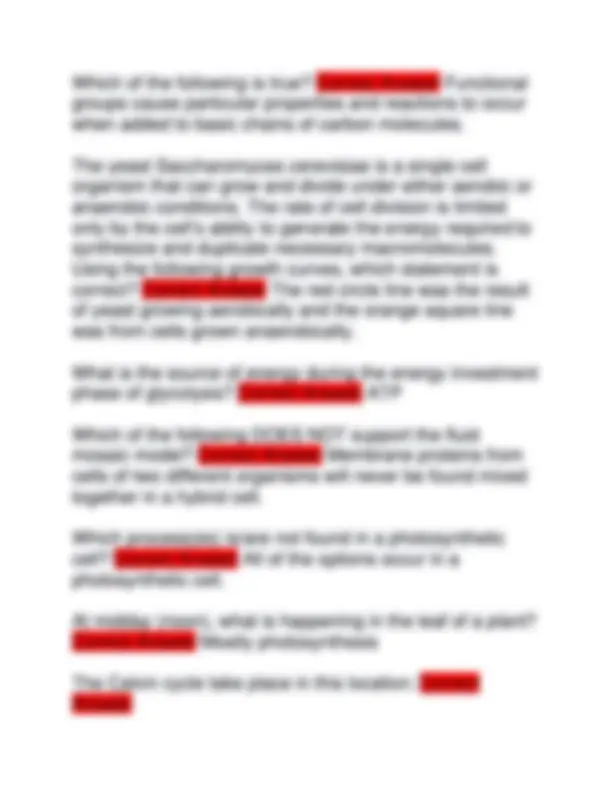
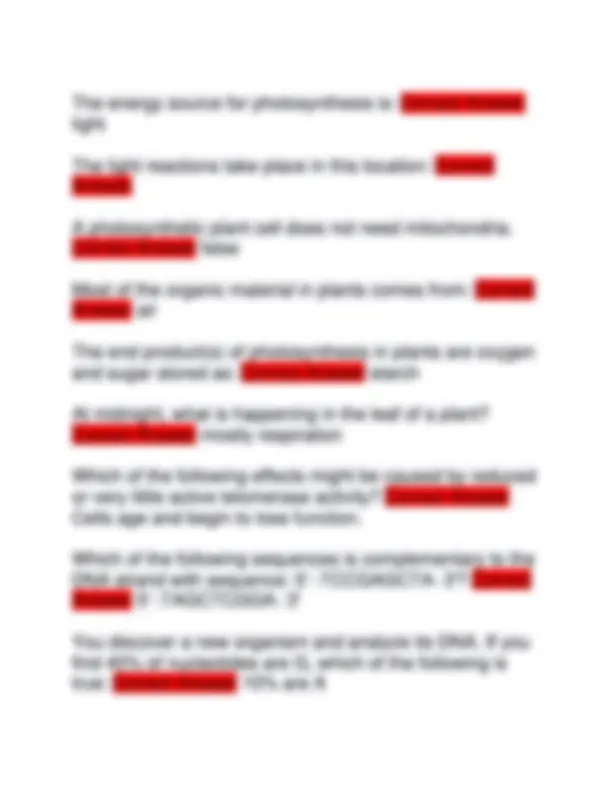
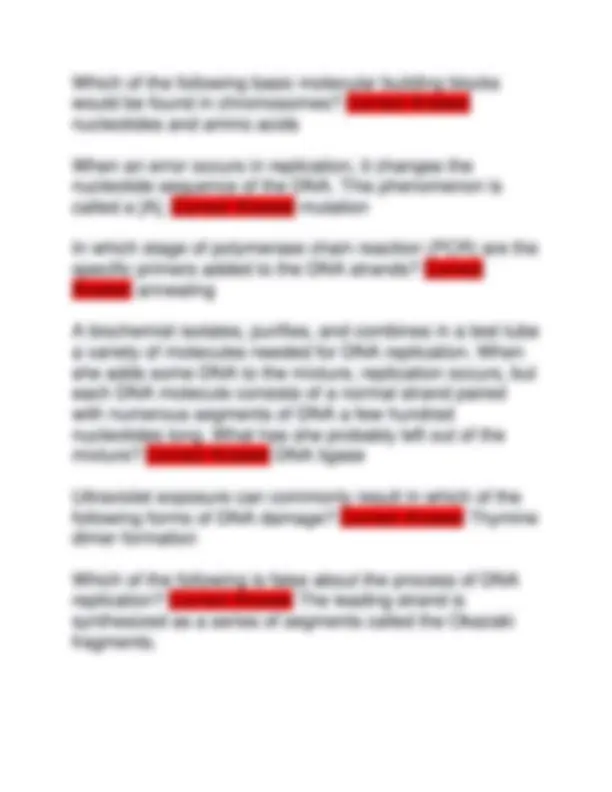
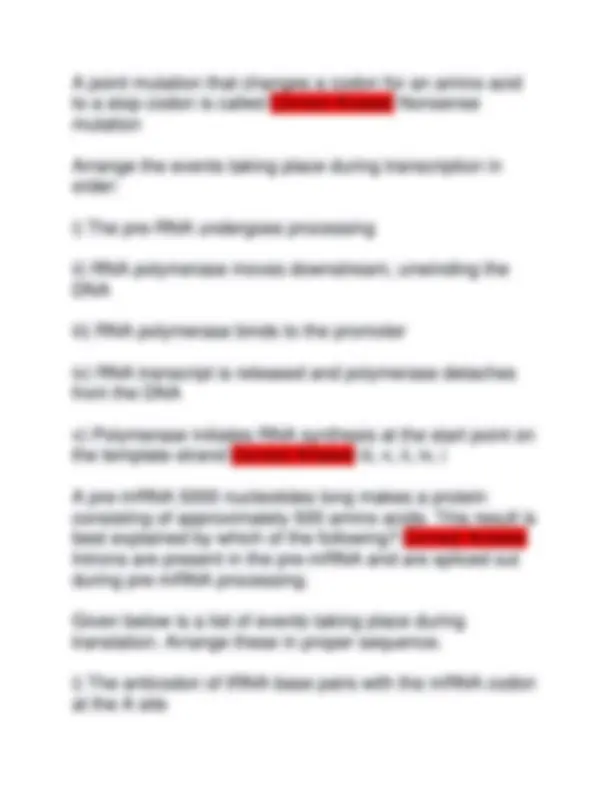
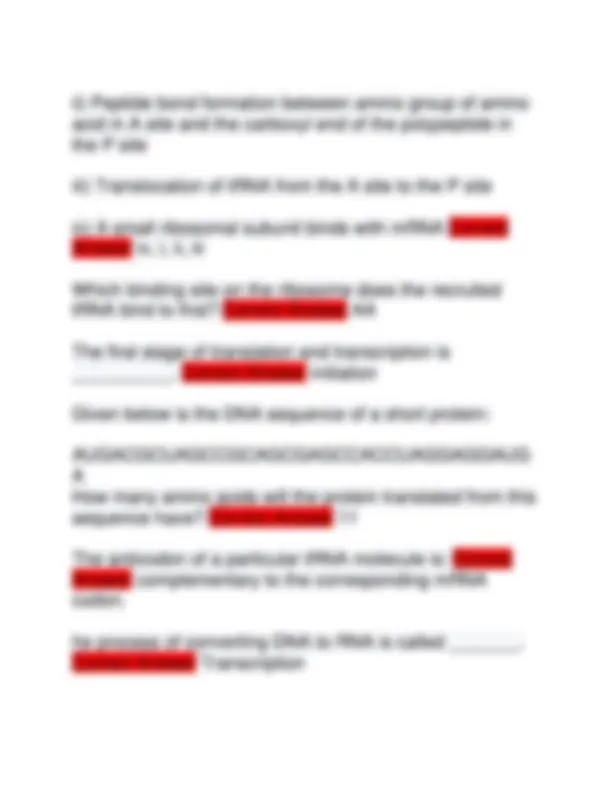
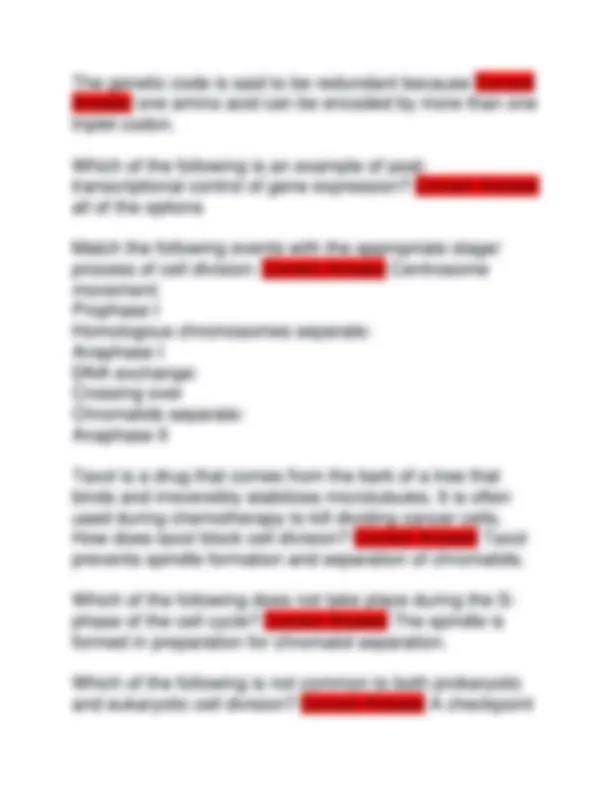
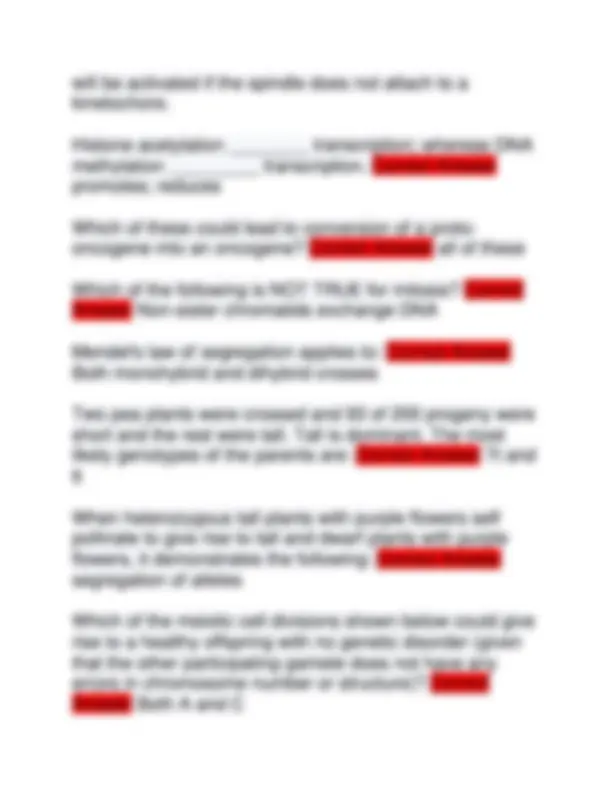
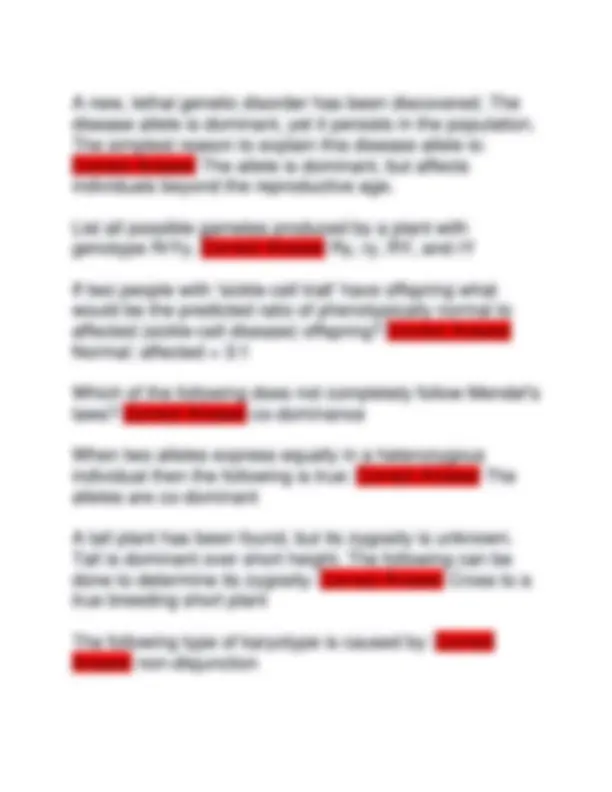
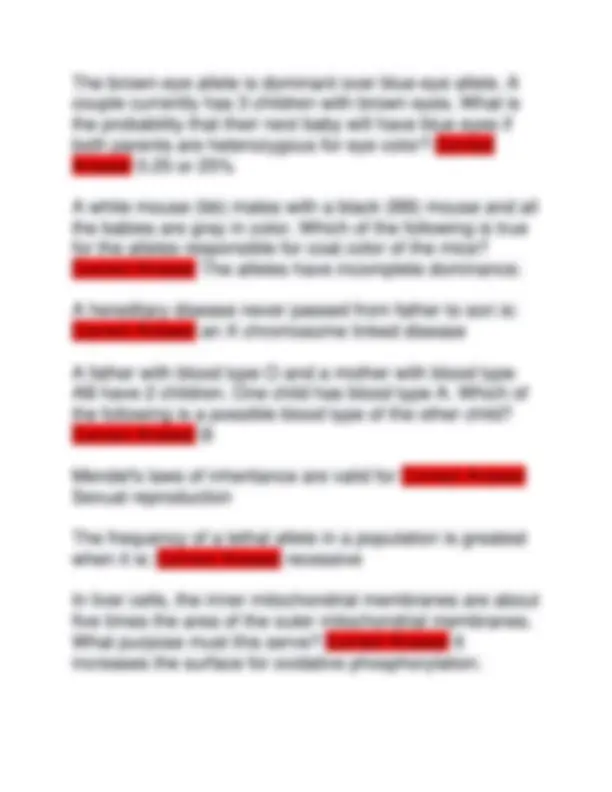
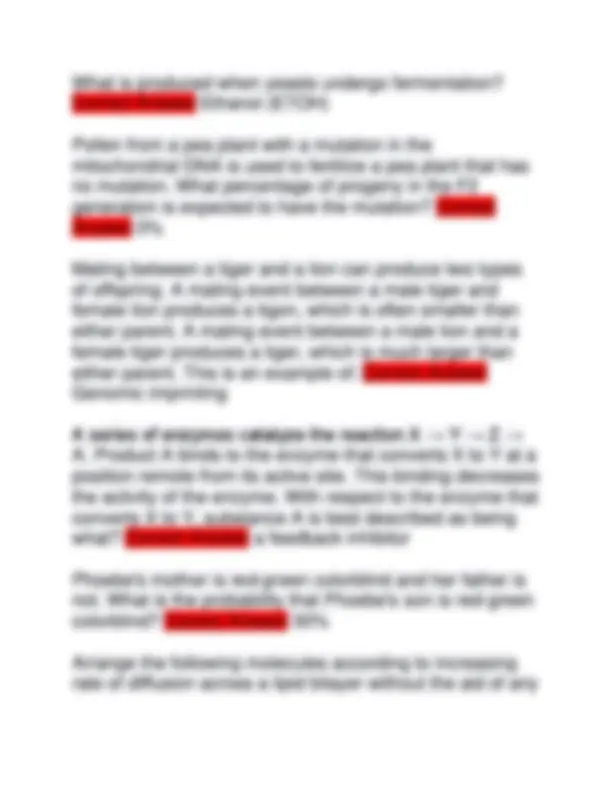
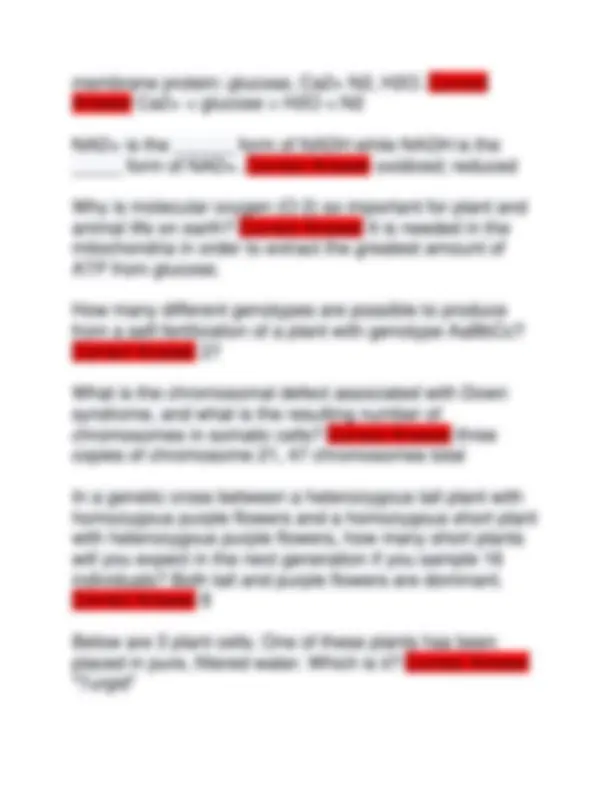
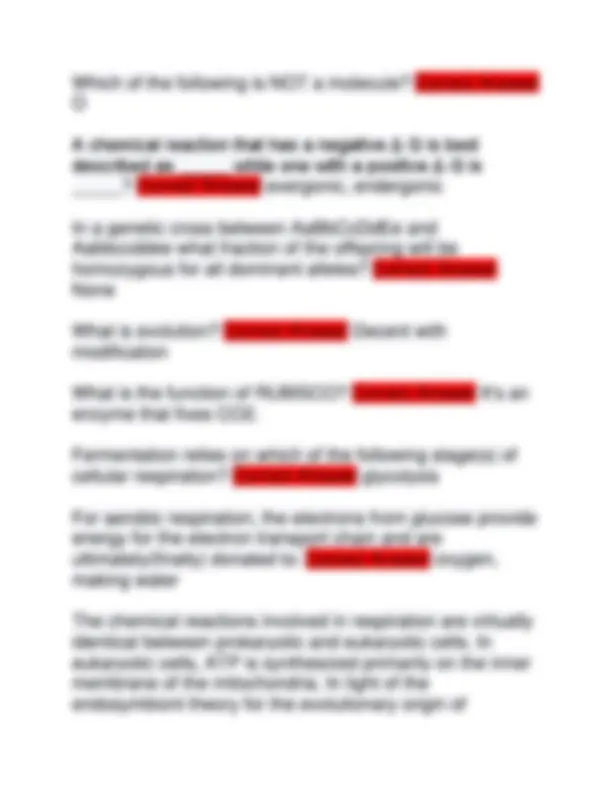
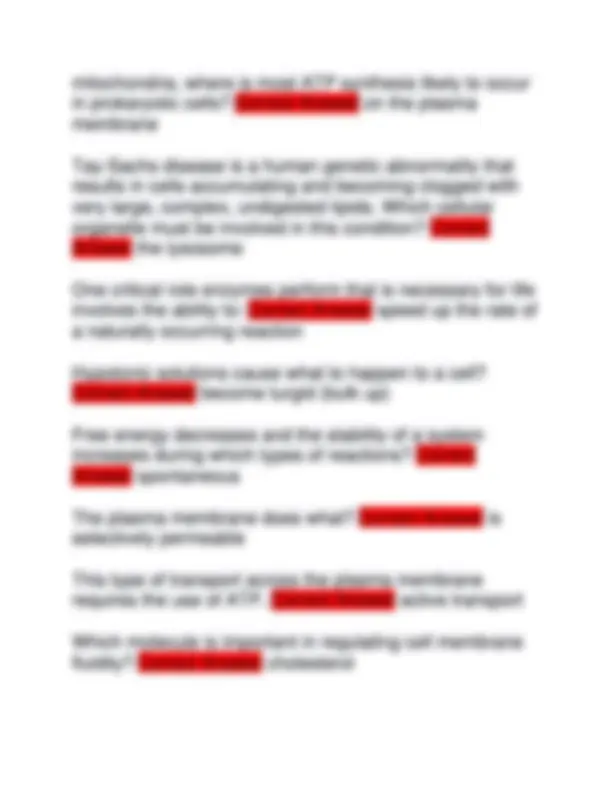
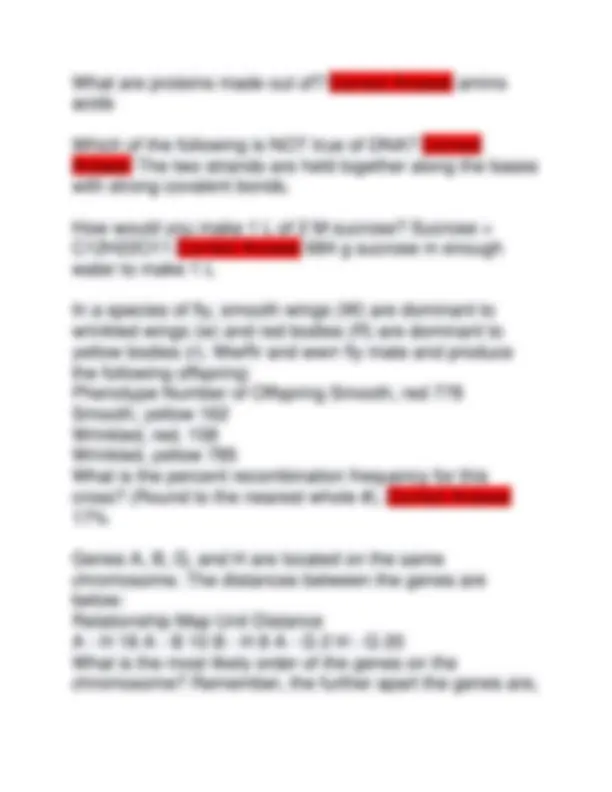
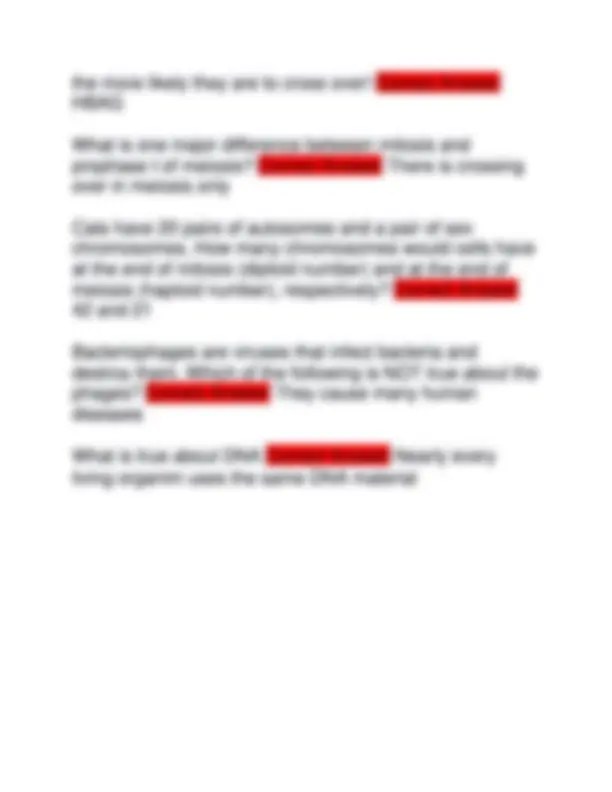


Study with the several resources on Docsity

Earn points by helping other students or get them with a premium plan


Prepare for your exams
Study with the several resources on Docsity

Earn points to download
Earn points by helping other students or get them with a premium plan
Community
Ask the community for help and clear up your study doubts
Discover the best universities in your country according to Docsity users
Free resources
Download our free guides on studying techniques, anxiety management strategies, and thesis advice from Docsity tutors
2025 BIO 111 FINAL EXAM QUESTIONS AND CORRECT ANSWERS (VERIFIED ANSWERS) | A+ GRADE 2025-2026
Typology: Exams
1 / 53

This page cannot be seen from the preview
Don't miss anything!














































The construction of macromolecules requires a series of ______________ reactions that form _____________ bonds between monomers. A) hydrophilic; covalent B) hydrolysis; polymer C) denaturation; ionic D) dehydration; covalent E) cohesive; ionic Correct Answer D How many grams of the compound in the figure above would be required to make 2.5 L of a 1 M solution? (Atomic masses of carbon = 12, oxygen = 16, hydrogen =
A) 210 B) 100 C) 60 D) 150 E) 350 Correct Answer D Dopamine is a neurotransmitter that functions as part of the reward-motivation behavior pathway. Which of the following is NOT true about this chemical? A) None of the above, they are all true about dopamine B) Can increase urine output C) It can be used as a vasodilator (to widen blood vessels)
D) Some people make too much have to take medication to decrease their levels E) It is only found in the brain Correct Answer E Element deficiencies can cause a lot of issues for all living organisms. What does a lack of Iron (Fe) cause in humans? Pick the alliment that was specifically addressed in class. A) birth defects B) anemia C) goiters D) cancer E) thyroid issues Correct Answer B Which of these structures is found in plant cells but not in animal cells? A) ribosome B) mitochondria C) golgi complex (apparatus) D) centrioles E) cell wall Correct Answer E Which unique property of water reduces variation in temperature along lake shores and coastal areas? A) Capillary action allowing water to flow against gravity. B) Water is an excellent, universal solvent. C) Density, solid water (ice) is less dense that liquid water allowing it to float. D) Water molecules at the surface tend to stick together (cohesion).
In taxonomic heirarchy, what is the correct order for the levels of classification of organisms? (Broadest to most specific.) A) species, genus, famiy, order, class, phylum, kingdom B) class, kingdom, order, phylum, genus, species, family C) kingdom, phylum, class, order, family, genus, species D) kingdom, phylum, species, family, genus, order, class E) class, order, family, kingdom, genus, species, phylum Correct Answer C What is unique about 14C and how many protons does it have? A) It is stable and has 8 protons B) It is stable and has 6 protons C) It is unstable and has 12 protons D) It is unstable and has 6 protons E) It is unstable and has 8 protons Correct Answer D Alfred Wallace is best known for what? A) Suggesting natural selection as a mechanism for evolution. B) Being the "father of taxonomy" and coming up with a system of organization. C) The first person to desribe a cell and credited with the cell theory. D) The theory of endosymbiosis leading to the evoluton of the mitochondria & cholorplast. E) Coming up with a standardized method of research (the scientific method). Correct Answer A
From the graph above, where in the human body would you most likely find pepsin? A) Stomach B) Liver C) Blood D) Heart E) Brain Correct Answer A The fluid inside a thylakoid of a chloroplast has 1000 times the concentration of H+ ions as the fluid in the stroma of the chloroplast. If the stroma fluid is pH 7.5, what is the pH of the thylakoid fluid? A) 8. B) 4. C) 5. D) 10. E) 3.5 Correct Answer B Which of the following is FALSE about the relationship between catabolism and anabolism? A) The ATP generated from anabolic reactions drives catabolic reactions. B) Both pathways involve enzymatic activities. C) Products of catabolic processes provide substrates for the anabolic processes, and vice versa. D) catabolic reactions are spontaneous, anabolic reactions are nonspontaneous E) Catabolism is exergonic, while anabolism is endergonic. Correct Answer A
What do mitochondria and chloroplasts have in common? I. double membrane II. make sugar from air and light III. found in almost all animal cells IV. found in almost all plant cells V. evolution from endosymbiotic events A) I,II,III,IV,V B) II,III,IV C) I,III,IV,V D) I,IV,V E) I,II,IV Correct Answer D Cyanide inhibits the transport of electrons to oxygen. Cyanide is most likely inhibiting: A) citric acid cycle B) pyruvate oxidation C) glycolysis D) electron transport chain Correct Answer D Which of the following is true of enzymes? A) Enzymes increase the rate of chemical reaction by lowering the activation energy. B) Enzyme function is increased if the 3-D structure or conformation of an enzyme is altered. C) Enzyme function is independent of physical and chemical environmental factors such as pH and temperature. D) Enzymes increase the rate of chemical reaction by providing activation energy to the substrate. Correct Answer A
Which organelle is responsible for containing degradative enzymes enclosed in a membrane that help remove waste products? A) ribosomes B) Golgi apparatus C) mitochondria D) lysosomes E) endoplasmic reticulum Correct Answer D Which of the following is NOT considered part of the cell's endomembrane system? A) vacuole B) mitochondria C) endoplasmic reticulum D) vesicles E) golgi apparatus Correct Answer B We discussed auto brewery syndrome while talking about fermentation. Which of the following is NOT true about this condition? A) someone with this can make themselves drunk after eating a meal high in carbs B) it usually occurs after taking a strong dose of antibiotics C) it's usually caused by an influx of Saccharomyces cerevisiae (brewer's yeast) D) overgrown bacteria mix with carbs to undergo fermentation Correct Answer D What kinds of molecules have the most trouble passing through a cell membrane?
Which of the following statement about the above transport is INCORRECT? A) it opens/closes (changes shape) when a phosphate group is added to or removed from it B) It is a Na+/K+-ATP electoron pump C) it is a pump for active transport of two K+ into the cell and three Na+ out of the cell D) it is a pump that utilizes ~ 25% of the total ATP produced E) it is a pump for passive transport of two K+ into the cell and three Na+ out of the cell Correct Answer E A cell uses one ATP molecule to help reactants X and Y form a product X-Y. What is left of the ATP after this reaction? A) ADP and a phosphate group. B) ATP (ATP is not changed by the reaction.) C) Nothing. The ATP is completely consumed. D) ribose, adenine, and three phosphate groups E) AMP and two phosphate groups. Correct Answer A Which of the following allows water to move much faster across cell membranes? A) ATP B) aquaporins C) the sodium-potassium pump D) cholesterol E) peripheral proteins Correct Answer B
Last week, biolgists in Tel Aviv released a ground breaking discovery. There were the first group to find a multicellular animal that __________? A) completely lacks a mitochondrial genome. B) can live forever. C) can destroy energy. D) can successfully do photosynthesis. E) completely lacks a nuclear genome. Correct Answer A HIV is the virus that causes AIDS. In the mid-1990s, researchers discovered an enzyme in HIV called protease. Once the enzyme's structure was known, researchers began looking for drugs that would fit into the active site and block it. And this strategy for stopping HIV infections is currently successful, and is anexample of what phenomenon? A) vaccination B) denaturation C) competitive inhibition D) allosteric regulation Correct Answer C Which of the following is NOT true about the Kreb's Cycle A) it uses both enzymes and coenzymes B) it is a series of enzymatic reactions that converts one product/compound into another C) it occurs in the mitochondria so only Eukaryotes can do it D) it occurs in the cytoplasm so every living organism can do it E) the main goal is to gather electrons for the eletron chain transport Correct Answer D
A) The patient's red blood cells will shrivel up as the water will move out of the blood cells B) The patient's red blood cells will become turgid as the water pushes against the cell wall C) The patient's red blood cells will not be affected at all as there is no net movment of water D) The patient's red blood cells will swell and possibly burst as the water moves into the cells Correct Answer D In the absence of oxygen, suppose a single yeast cell undergoes fermentation and uses 56 molecules of glucose. How many molecules of ATP will be generated? A) 56 B) 112 C) 100 D) 28 E) 224 Correct Answer B Which of the following is an example of potential rather than kinetic energy? A) water rushing over Niagara Falls B) a crawling beetle foraging for food C) a molecule of glucose D) light flashes emitted by a firefly Correct Answer C In oxidative phosphorylation, what is being oxidized and what is being phosphorylated? A) NADH; ADP B) NAD+; ADP C) ADP; ATP D) O2; ATP Correct Answer A
A biologist is studying a cell that has enzymes, DNA, a plasma membrane, ribosomes, and mitochondria. Given only this information, this cell COULD BE A) a plant cell but neither a bacteria cell nor an animal cell. B) a bacteria cell but not a plant cell. C) a bacteria cell or a plant cell. D) a plant cell or an animal cell but not a bacteria cell. E) an animal cell but not a plant cell. Correct Answer D What is produced when animals undergo fermentation? A) Lactic acid B) Ethanol (ETOH) C) Oxygen D) Sugar Correct Answer A Substrate-level phosphorylation accounts for approximately what percentage of the ATP formed by the reactions of glycolysis? A) 2% B) 38% C) 0% D) 100% Correct Answer D The first law of thermodynamics means that: A) The universe tends toward disorder and randomness B) Plant cells cannot create their own energy C) Pyruvate oxidation is an endergonic reaction D) No energy is transfered during the citric acid cycle Correct Answer B
B) Unsaturated fatty acids have a higher cholesterol content, which prevents adjacent lipids from packing tightly. C) The double bonds block interaction among the hydrophilic head groups of the lipids. D) Unsaturated fatty acids are more nonpolar than saturated fatty acids. Correct Answer A Which of the following is true of osmosis? A) Osmosis can only happen in cells. B) In osmosis, water moves across a membrane from areas of lower solute concentration to areas of higher solute concentration. C) Osmosis only takes place in red blood cells. D) In osmosis, solutes move across a membrane from areas of lower water concentration to areas of higher water concentration. E) Osmosis is an energy-demanding or "active" process. Correct Answer B The idea of emergent properties is a central theme found in biology. Which is NOT true about this theme? A) Large, complex molecules are built from tiny, simple molecules. B) It explains how life on earth emerged. C) Everything from cells to the biosphere has a structured, hierachal organization. D) The sum is greater than its constituent parts. E) Life's basic characteristics have a high degree of order. Correct Answer B
Which of the following is NOT a function of a lipid? A) Building blocks for some hormone synthesis B) Insulation from the environment C) Store genetic information D) Component of cellular membranes E) Long-term energy storage Correct Answer C In its simplest and broadest version, how do we define natural selection? A) Change over time B) Decent with modification C) Only the strong survive D) Differential reproductive success E) Survival of the fittest Correct Answer D You need to make a half liter of a 1M solution of maltose for your fermentation lab. How will you do that? 4) Maltose is C12H22O11 (MW of each is C=12, H=1, O=16). A) Add 171 grams to 1 liter of water. B) Add 342 grams to 500 mL of water. C) Add 29 grams to 500 mL of water. D) Add 171 grams to 500 mL of water. E) Add 342 grams to 1 liter of water. Correct Answer D Which of the following is NOT true of DNA? A) The two strands are held together along the bases with strong covalent bonds. B) Its nucleotides have deoxyribose sugar. C) Its shape is like a twisted ladder. D) It is made of nucleotides with the bases A, G, C and T.
B) They are not present (without other bonds) in most living organisms. C) They have hydrophobic regions. D) They easily dissolve in water. E) They are only composed on hydrogens and carbons (but can make bonds with other compounds). Correct Answer D What is the function of the polysaccharides cellulose and chitin in the cell? A) ready source of energy B) transport into and out of the cell C) structural support D) long-term storage of energy E) coordination of cell activities Correct Answer C In what way does RNA differ from DNA? A) DNA base sequences carry information; RNA base sequences do not. B) DNA has four different bases; RNA has only three bases. C) DNA is very unstable and will denature very quickly. D) DNA monomers each have a sugar molecule component; RNA monomers do not. E) RNA (gene expression) can change hourly in organisms. Correct Answer E Electronegativity is the attraction of a particular atom for electrons in a covalent bond. Which type of bond has the largest difference in the electronegativity of the atoms being joined? A) Ionic
B) Van der Waals Interactions C) Polar covalent D) Hydrogen E) Non-polar, covalent Correct Answer A Darwin's mechanism for evolution requires A) inheritance of characteristics that enhance survival and reproduction B) equal reproductive success among species members C) organisms to evolve very quickly to their ever changing environment D) no variation among species members so they can recognize each other and mate E) fewer offspring to be produced so there are plenty of resources Correct Answer A A solution with a pH of 9 has how many H+ ions in it compared to a solution with a pH of 6? A) 100 times less B) 3 times less C) 100 times more D) 3 times more E) 1000 times less Correct Answer E What differentiates a hypothesis from a theory? A) A theory can be proven, a hypothesis cannot. B) A theory is a principle that has been formed as an attempt to explain things that have already been substantiated by decades of data. C) Neither can be refined after the initial experiment has started.